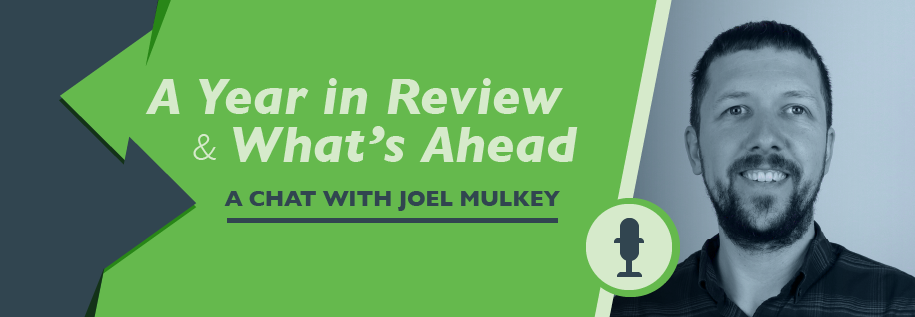We had an opportunity to sit down recently with Bigleaf founder and CEO, Joel Mulkey, to get his perspective on the year that was and what to expect in the coming year.
As you might expect, SD-WAN played a significant role this year — from helping people stay online and connected throughout the ongoing pandemic, to improving the quality and reliability of cloud-based applications for companies continuing to adapt to hybrid work environments.
Joel also touched on increased urgency companies are putting behind digital transformation initiatives, as well as how innovative technologies like smart AI are becoming a valuable way for MSPs to address the growing skills gap their businesses and customers face.
You can listen to the conversation here or read the transcript below.
Audio Transcript
Mike: So, it’s been a wild year. Let me rephrase that. Another wild year. We thought it’d be good to hear from Bigleaf Networks founder and CEO, Joel Mulkey, about some of what he’s seen over the past 365 days. And what he sees in his crystal ball for the next 365. Welcome, Joel.
Joel: Thank you, Mike. It’s great to chat. Yeah, it has been a well…the expectations for what years look like nowadays are a little different, I guess. How about that?
Mike: 300 and some odd days. They just keep going. So, let’s jump right on in. So, the ongoing pandemic is the obvious elephant in the room for every business still navigating this, I hate to say it, but this new normal. And I know you talk to a lot of fellow business owners. How are they doing?
Joel: Yeah, well, I think it varies. I mean, I think everyone is feeling this sense of expectations are uncertain. And I mean, look at what we’ve got right now, with Omicron coming up and the unknowns from that. I think people feel and then there’s definitely a wish for, “can we just put that behind us?” and “let’s get back to the things we enjoy in life and the ways we want to interact.” And obviously, there’s a lot of perspectives to that. Some folks want to hole up in their homes and lock the doors and until COVID magically goes away somehow. And then others I think, you know, we just wish that it never happened and wasn’t a part of life.
So I, I think for Bigleaf, what we’re seeing is we have to embrace reality, which is there are a lot of new unknowns in the world today from that. And technology can be a great help. I mean, look at what we’ve been able to do in the business world of staying online and connected and driving growth and making things work in life because we have the likes of video conferencing and e-commerce and so many technology elements. That’s been great to see.
Mike: And obviously, connectivity is a huge issue now. So, now that so many people are working from home and, you know, stealing vital bandwidth from their families’ Netflix and Twitch streams for things like Zoom, calls for their bosses, coworkers, and clients. How has residential broadband been able to handle the increased enterprise load?
Joel: Well, I think everyone’s done a good job with them. You look back in the early days of the lockdowns in the US where some of the residential networks got a little bit overloaded, especially on the upload side. Your DSL and cable sort of connections were just not quite prepared for all the video conferencing at home. But I think that was pretty quick and got resolved. And we really see that from a bandwidth perspective. Networks are built out to handle video today and the demands of your Netflix and YouTube and all that in the evening far outweigh the throughput requirements of basically any work-from-home business use cases for people in the office. That said, I mean, that doesn’t change the situation that bandwidth is only one element of connectivity. And we just continually see. You look at our couple thousand customers where they’re saying, “Hey, it doesn’t really matter how much bandwidth I have. What I need is quality and reliability.” And that is definitely a complex scenario in the residential internet world. There are far more variables to the network than in a big enterprise downtown high rise, for example. So, it’s complicated.
I think a lot of application providers have done a good job getting around that, where they can. You look at Microsoft and their strategy to get their front doors in place to peer really closely with ISPs. And Google’s taking a similar approach. And the application providers, they look at what the work they’re doing in Teams and Zoom and other things. A lot of smart people are dedicating a lot of effort to getting around those connectivity problems. Unfortunately, they don’t go away. We’ve seen that even with all of that focus and money and dedication [on] the network, that the internet is not providing the level of service that business people need to get work done without distractions and inefficiency and outages. So that’s where Bigleaf exists, of course, to solve those problems. And we’re seeing a lot of demand and need, especially now that these work from home, work from anywhere, and more digital transformation initiatives are happening at an even higher rate.
Mike: Yeah, I think we’re attuned to, you know, to on and off, to outages, right? We can do it. We can deal with that as humans and as folks that have grown up with us. And it’s the quality and the reliability piece that you mentioned, right? The sort of the brownout level stuff that really that really throws us. And that’s sort of the challenge that I think a lot of people have right now.
Joel: And you remember when it used to be normal to go into a tunnel and your cell phone would cut out? We thought that was okay and fine. Well, now, that’s just not okay anymore, right? We have a new expectation for our cell phones. The same thing is happening with internet connectivity, where today, I think a lot of folks [who are] on a Zoom call and it gets all choppy, you just accept that. And you’re okay with how it agitates you and gives you Zoom fatigue, like you just kind of accepted that’s part of life.
Well, we need to get over that. We need to set a new bar for expectation; that connectivity should always work. And our application experience shouldn’t be crummy. So, that’s really something we’re focusing in on is how can we set that bar and inform people there is better out there than what Comcast or Verizon or Spectrum are giving you.
Mike: An SD-WAN has become pretty much the foundation for a lot of these new business realities. How has it helped folks? You know, especially, I would imagine, you know, we know enterprises are dealing with this and they’ve got the resources to sort of try and tackle it. But a lot of folks that are running small and medium sized businesses and this is not their normal realm, and there they have to deal with us.
Joel: Yeah, I think that’s part of that kind of setting the new bar. We’re trying to inform those folks, hey, it’s not just what your carrier gives you that is the extent of your options. There are ways to get better than that. You can use SD-WAN to combine multiple carriers together and to route traffic intelligently over paths that will give your applications a better experience.
So, we’re seeing that play out where once folks are aware of this functionality, we can provide and bring that onboard. Their eyes are opened to hey, we actually can rely on this technology platform for our key business needs, which is really exciting.
So, making sure that people understand that those pieces of connectivity that go beyond speed, the reliability, the latency, jitter, packet loss, these performance metrics. There’s a ways to go beyond what the industry normally gives you. You just have to kind of be aware that these solutions, like Bigleaf, are out there.
Mike: And I have to think that this digital transformation to shift to the cloud has taken on even greater priority for a lot of businesses and a lot of industries. Are there any industries where you’ve seen an increased uptick in interest in SD-WAN?
Joel: You know, it’s fairly broad. What we tend to work with are companies who their IT teams aren’t massive. So, they need smart AI, like what we bring, to manage that experience. Healthcare is an area we noticed especially notable demand this year. If you’ve got multi-site, healthcare clinics and you’re trying to manage all that with a team of three or four or five folks, that’s just a lot of load on that team. And they have a lot of need for connectivity to cloud and SaaS and site-to-site networking. So, having an intelligent network platform that takes a lot of that load off, that does a fair amount of that decision-making autonomously, has been important for them.
There’s other places that we see that pretty applicable. You know, even legal offices and accountants and those sorts of folks, to manufacturing organizations, where you got orders coming to and from a factory all the way to gamers, you know, that are trying to make a living and playing games online. It’s really broad. But healthcare is a notable one we’ve seen this year,
Mike: You made a mention of, I thought I heard you say something about, an intelligent platform. Tell me a little bit more about that.
Joel: Yeah, well, I think if you compare how networking used to be. You go buy a Cisco router and you plug that into your network and you set it up and tell it what to do. You set up, hey, here’s all the parameters of how to perform. We’re going to set up some routing protocols and some access lists, and all these different policies. And then a human has to maintain that.
So, if you need to add a new application to your network and make sure it gets treated well, that is prioritized, for example. Somebody has to go log in and update those devices. And that way of doing things worked fine when your enterprise, your business, had 510 apps that you relied on and you had control over the network experience. The apps lived in the server closet down the hall.
Well today, when there’s 100 apps that your business relies on and people can add them at any time with a credit card, and they live all over the world in different data centers and SaaS platforms. Now, your network needs to handle that stuff itself. If you have people trying to manage all these policies to ensure that users are happy, no one’s going to be happy. So that’s where platforms like Bigleaf come into play to automatically identify those different kinds of traffic and handle them according to the needs of each traffic stream. So, if a user signs up for WebEx tomorrow, Network Administrators shouldn’t have to go in and create new policies for how to handle that traffic. The network platform should be intelligent enough to do that automatically. So, we find Bigleaf customers saying, “Hey, I like the AI approach to how this works,” and really using Bigleaf as the foundation for all of their connectivity in their applications; going forward to adapt in real time as they grow and morph their business.
Mike: And that skills gap has got to be a boon to MSPs and other resellers and channel players, I would imagine. I know there was a Techaisle study recently that saw a gap between what small enterprises need and what MSPs believe they should offer. And to me gap always sounds a lot like another word for opportunity.
Joel: Yeah, I think this touches on the complexity of technology today, where there’s so many ways to do things. And there’s so many needs that businesses have having a skilled consultant, whether you’re a telecom agent, or an ISP, excuse me, an MSP or a VAR. Any, anyone like that can really bring a lot of value to the customer…that those parties have already filtered through all the solutions on the market, identify the ones that work well, the ones who partner well with them, who can bring a good experience to the customer.
So, we really value those relationships and see that, hey, we’re not deployed in every single customer location for our partners. But the partners do a great job of filtering out which of their customers need Bigleaf and which ones need something else. And which ones maybe they don’t have one of those needs because they’re not to this point in their business or something.
Mike: So, let’s shift gears just slightly and talk a little bit about what’s been happening at Bigleaf. You guys made some pretty cool moves in 2021.
Joel: Yeah, yeah, it’s been an interesting year; one that we’ve had some really healthy changes. We’ve also seen, again, the continuation of the pandemic in many ways where we hoped it would go away. Here we are today with the remnants and the next step. So yeah, it’s been, it’s been interesting, and good.
Mike: Any new products and features that you’re that you’re most proud of.
Joel: So, we put a lot of energy this year into what we call Zero Touch Setup. And this is us taking and migrating the way that Bigleaf service is delivered to really enable our MSP partners to turn services up without having to involve us. We want to make it so they can work in the workflows that they prefer, and the timing they prefer. So, that was a big shift for us and helpful for them.
We’ve also invested a lot in our MSP channel, just generally. This is something we really kicked off heavily, early 2020. And with the pandemic, it’s funny, one of our team members noted today that just a couple months ago was the first time we’ve been able to get in an in-person event with those channel partners. So well, [while] we’ve had to sort of adapt and do virtual events, we’ve been able to see that channel grow aggressively this year. And we’re gonna continue to invest in that.
We’ve expanded our network as well. So, we launched a new data center in Virginia, as kind of a hub for data centers. Things called Data Center Alley, for many folks. Amazon’s AWS East region is there. And so that’s been something that we’ve really directly responded to customer partner requests. And we’ve had good presence in the Northeast already with our New York POP, but had requests for that. So, brought that to market.
In addition, less public-facing, but we’ve significantly expanded capacity in our network. [We] went through a big project this year to grow that capacity transparently to our customers. With props to our internal teams for doing that. It was a lot of work.
Mike: Exciting. Now looking forward, as it’s the end of the year and as as folks are wont to do. What are some of the things you think folks should keep an eye on over the next year? Some of your predictions and things that we will see in 2022, or whatever year we’re gonna call that now?
Joel: You know, I think that was something we realized in September. We were going to kind of do a hybrid office setup and instead had to say, hey, we’re gonna go fully remote and stay remote for the foreseeable future. I think that’s going to play out across quite a few businesses in quite a few ways. So, that work-from-anywhere notion is here to stay, I think. I think we’re seeing there’s a demand from tech workers. There’s also a need based on the pandemic to continue that.
One of our great network engineers, he’s over in Korea right now. And it doesn’t really impact the work that’s happening. It’s pretty amazing to be able to jump on a Zoom call with them and interact. So, that sort of thing and businesses being able to leverage that, I think is going to stick around and plenty of employees are going to demand that. So, keeping an eye on that and sort of architecting businesses, technology platforms, access, security, etc. to accommodate it, I think, is going to be key.
You know, I mentioned a little bit ago, apps are getting better and smarter at dealing with connectivity issues. But there are limits to that. So, I think we’ll continue to see that. What we’ll see folks being very innovative about, hey, within the app, what can I do? Can I make it resilient to network problems? Can I build security into the app, so I’m not reliant on network security? Those sorts of smart folks are dedicated to building the SaaS apps and coming up with great things. That’s great. That won’t eliminate the fact that there are physical wires and connectivity issues to deal with. So, you’ll continually need a solution to that, something like Bigleaf, that will intelligently manage that connectivity path.
And then thirdly, I think AI is going to continue to be just something that transparently is working its way into life. We see that already today. When you call up somebody on the phone and you’re talking to AI before you get to talk to a person. Or you pop up, you know, support on Amazon or Google and you’re probably talking to AI first. There’s AI behind the scenes looking at your recent orders, figuring out who you should talk to, and how to respond to you. This sort of, transparent to us…or maybe opaque to us, I don’t know how anyone describes it. We can’t see it but it’s happening. And in some ways, that’s problematic I suppose. But in the world of technology and networking and connectivity, I think it’s really valuable. You look at solutions like Bigleaf, where you’re, you’re getting the benefits of AI, and getting humans to be able to focus on the things where humans really need to focus rather than sort of the menial tasks that are a little more automatable. So, I think we’ll continue to see that play out. There’s a lot of folks investing energy and money there, which I think could be good.
Mike: Great. And no, no mention of NFTs or crypto. So, I give you high credibility already.
Joel: You know, I consider myself someone who enjoys reading about the bleeding edge and getting into some of that stuff. I don’t understand the NFT thing. Maybe I haven’t spent enough time on it. So, I’ll have to look more into that.
Mike: Well Joel, thank you. Thank you so much for giving us a look back and giving us a look into your crystal ball on what might be on the horizon. For more on the role SD-WAN plays in digital transformation and how Bigleaf can help you, visit bigleaf.net
Joel: Awesome. Thanks, Mike. Appreciate the time here and I think 2022 will be a great year.








